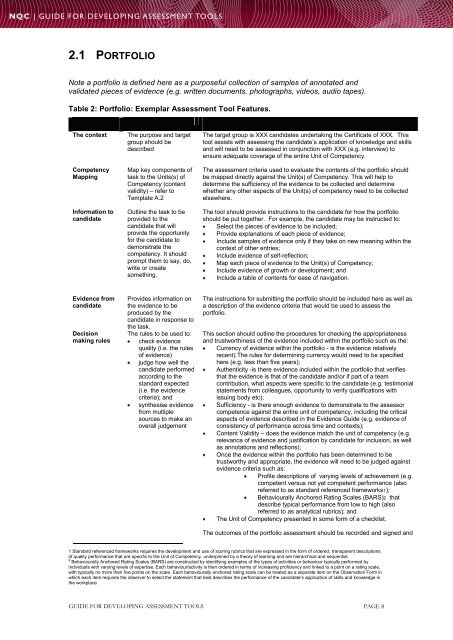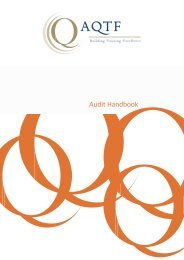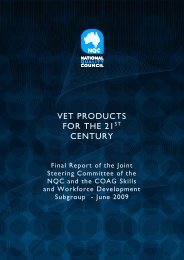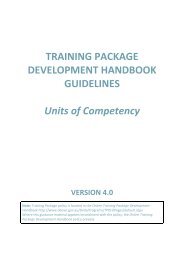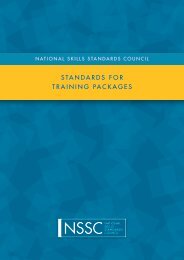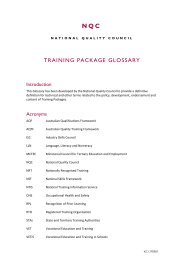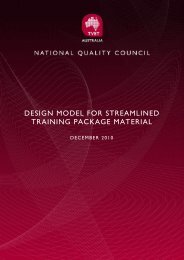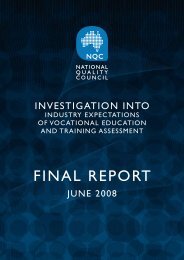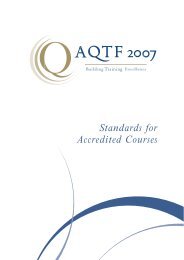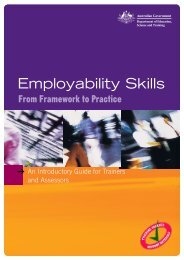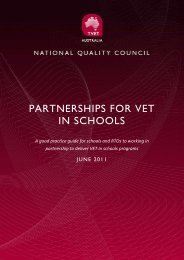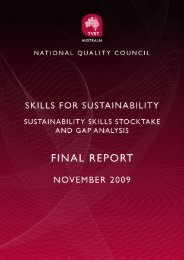Guide for Developing Assessment Tools - National Skills Standards ...
Guide for Developing Assessment Tools - National Skills Standards ...
Guide for Developing Assessment Tools - National Skills Standards ...
- No tags were found...
You also want an ePaper? Increase the reach of your titles
YUMPU automatically turns print PDFs into web optimized ePapers that Google loves.
NQC | <strong>Guide</strong> <strong>for</strong> developing assessment tools2.1 PORTFOLIONote a portfolio is defined here as a purposeful collection of samples of annotated andvalidated pieces of evidence (e.g. written documents, photographs, videos, audio tapes).Table 2: Portfolio: Exemplar <strong>Assessment</strong> Tool Features.Component Feature Generic ApplicationThe context The purpose and target The target group is XXX candidates undertaking the Certificate of XXX. Thisgroup should betool assists with assessing the candidate’s application of knowledge and skillsdescribedand will need to be assessed in conjunction with XXX (e.g. interview) toensure adequate coverage of the entire Unit of Competency.Competency Map key components of The assessment criteria used to evaluate the contents of the portfolio shouldMapping task to the Units(s) of be mapped directly against the Unit(s) of Competency. This will help toCompetency (content determine the sufficiency of the evidence to be collected and determinevalidity) – refer to whether any other aspects of the Unit(s) of competency need to be collectedTemplate A.2elsewhere.In<strong>for</strong>mation to Outline the task to be The tool should provide instructions to the candidate <strong>for</strong> how the portfoliocandidate provided to the should be put together. For example, the candidate may be instructed to:candidate that willSelect the pieces of evidence to be included;provide the opportunity Provide explanations of each piece of evidence;<strong>for</strong> the candidate toInclude samples of evidence only if they take on new meaning within thedemonstrate thecontext of other entries;competency. It should Include evidence of self-reflection;prompt them to say, do, Map each piece of evidence to the Unit(s) of Competency;write or createInclude evidence of growth or development; andsomething.Include a table of contents <strong>for</strong> ease of navigation.Evidence from Provides in<strong>for</strong>mation on The instructions <strong>for</strong> submitting the portfolio should be included here as well ascandidate the evidence to be a description of the evidence criteria that would be used to assess theproduced by theportfolio.candidate in response tothe task.Decision The rules to be used to: This section should outline the procedures <strong>for</strong> checking the appropriatenessmaking rules check evidence and trustworthiness of the evidence included within the portfolio such as the:quality (i.e. the rules Currency of evidence within the portfolio - is the evidence relativelyof evidence)recent).The rules <strong>for</strong> determining currency would need to be specifiedjudge how well the here (e.g. less than five years);candidate per<strong>for</strong>med Authenticity -is there evidence included within the portfolio that verifiesaccording to thethat the evidence is that of the candidate and/or if part of a teamstandard expected contribution, what aspects were specific to the candidate (e.g. testimonial(i.e. the evidencestatements from colleagues, opportunity to verify qualifications withcriteria); andissuing body etc);synthesise evidence Sufficiency - is there enough evidence to demonstrate to the assessorfrom multiplecompetence against the entire unit of competency, including the criticalsources to make an aspects of evidence described in the Evidence <strong>Guide</strong> (e.g. evidence ofoverall judgement consistency of per<strong>for</strong>mance across time and contexts);Content Validity – does the evidence match the unit of competency (e.g.relevance of evidence and justification by candidate <strong>for</strong> inclusion, as wellas annotations and reflections);Once the evidence within the portfolio has been determined to betrustworthy and appropriate, the evidence will need to be judged againstevidence criteria such as:Profile descriptions of varying levels of achievement (e.g.competent versus not yet competent per<strong>for</strong>mance (alsoreferred to as standard referenced frameworks1);Behaviourally Anchored Rating Scales (BARS)2 thatdescribe typical per<strong>for</strong>mance from low to high (alsoreferred to as analytical rubrics); andThe Unit of Competency presented in some <strong>for</strong>m of a checklist. The outcomes of the portfolio assessment should be recorded and signed and 1 Standard referenced frameworks requires the development and use of scoring rubrics that are expressed in the <strong>for</strong>m of ordered, transparent descriptionsof quality per<strong>for</strong>mance that are specific to the Unit of Competency, underpinned by a theory of learning and are hierarchical and sequential.2Behaviourally Anchored Rating Scales (BARS) are constructed by identifying examples of the types of activities or behaviour typically per<strong>for</strong>med byindividuals with varying levels of expertise. Each behaviour/activity is then ordered in terms of increasing proficiency and linked to a point on a rating scale,with typically no more than five points on the scale. Each behaviourally anchored rating scale can be treated as a separate item on the Observation Form inwhich each item requires the observer to select the statement that best describes the per<strong>for</strong>mance of the candidate’s application of skills and knowledge inthe workplace.GUIDE FOR DEVELOPING ASSESSMENT TOOLS PAGE 8


